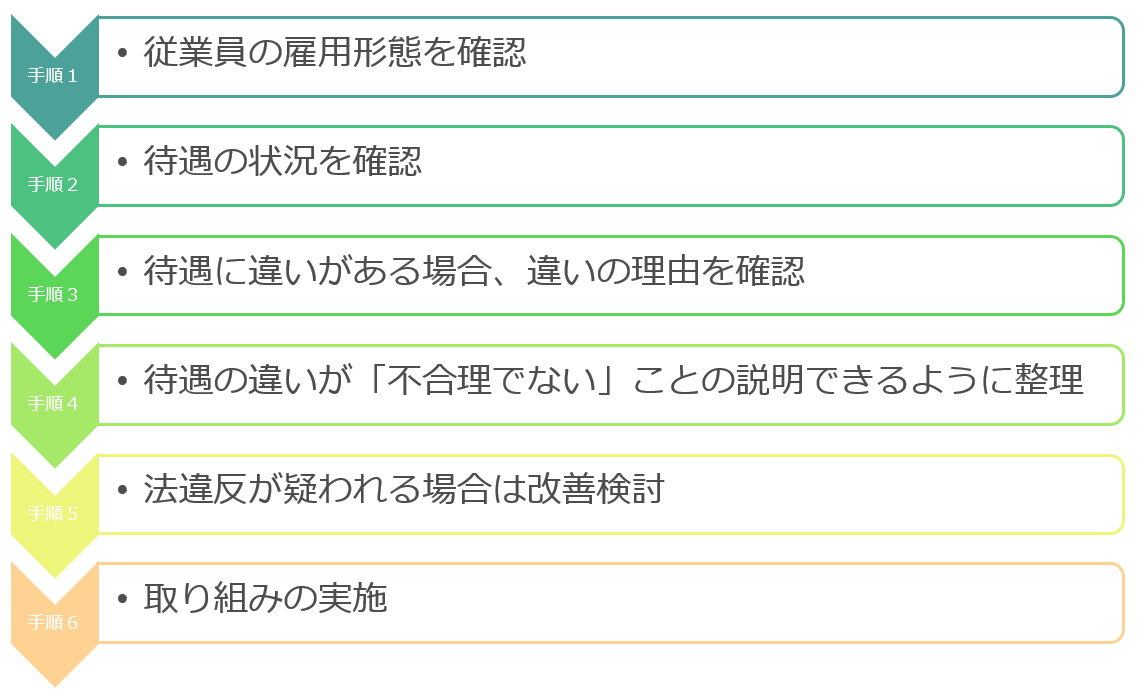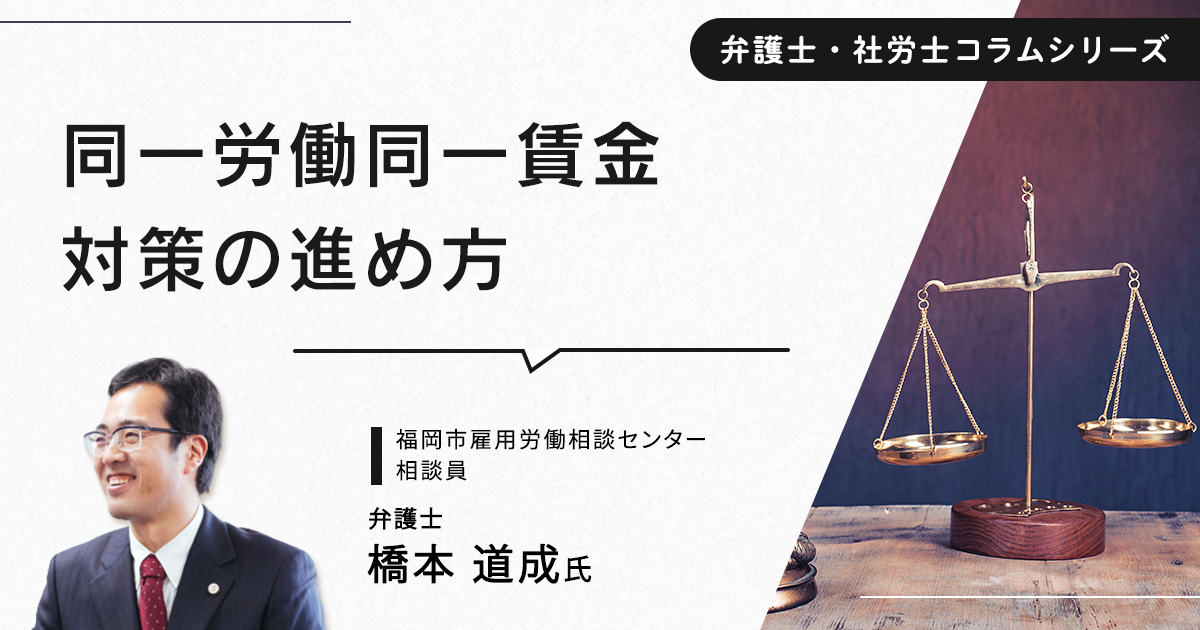Recently, I think we have had more opportunities to hear the term equal pay for equal work. However, there are many people who do not understand the contents well.
In this column, I would like to explain what equal pay for equal work is, and then write about specific things to be aware of.
1 What is equal pay for equal work?
It is said that equal pay for equal work is an effort to ensure equal and balanced treatment that does not concern the form of employment, whether regular or non-regular, and to realize equal pay for equal work, aiming to eliminate the unreasonable difference in treatment between so-called regular and non-regular workers (see draft equal pay guidelines for equal work as of December 20, 2016).
The point here is two.
The first is to eliminate the unreasonable difference in working conditions between regular and non-regular workers, and the difference in working conditions between regular and non-regular workers is not covered here.
The second is that the treatment includes not only wages, but also non-wage allowances and working conditions such as holidays.
2. The Idea of Equal Pay for Equal Work
So what specifically is the problem?
One of the cases that became a problem in the court case was whether such a difference in treatment could be said to be unreasonable if, for example, a full-time employee was paid no accident allowance, school lunch allowance, housing allowance, etc. for a full-time employee, but not a contract employee (see Hamakyorex case).
A brief framework for the Supreme Court's decision is as follows:
[3 steps of the Supreme Court's judgment framework]
【Step 1】
Three factors examining the differences between regular and non-regular workers
(1) Job description
(2) Scope of changes in the content and arrangement of duties
(3) Other circumstances
【Step 2】
Examination of the purpose and nature of the working conditions that are considered to be a problem
【Step 3】
Consider whether the difference in working conditions between regular and non-regular workers can be explained from the three factors discussed in Step 1
For example, in the Hamakyorex case (Supreme Court decision June 1, 2018), which I mentioned earlier as a reference example, the Supreme Court ruled as follows.
[Hamakyorex Incident]
【Step 1】
・ There is no difference in the job description of the driver
・ Regularly employed workers may be transferred or transferred, but non-regular workers may not
There was a difference such as.
As step 2, we judged the purpose and nature of each allowance as follows.
【Step 2】
Accident-free allowance: Aim to train paid drivers and win customers through safe transportation
School lunch allowance: Subsidy for meals during employees' working hours
Housing allowance: Subsidizes the cost of housing for employees
Based on this decision, step 3 was to determine whether each difference could be explained.
【Step 3】
Accident-free allowance: There is no difference between the two in the necessity of safe driving and accident prevention
→. It's an unreasonable difference in treatment.
School lunch allowance: There is no difference between the necessity of eating during working hours
→. It's an unreasonable difference in treatment.
Housing allowance: Regularly employed workers are required to pay housing allowances because they can spend more on housing than non-regular workers because they are scheduled to change their placement with a transfer or a transfer.
→ is not an unreasonable difference in treatment.
In 2019, two rulings in the Hamakyorex case and nagasawa transportation case were issued in the Japan Post case (Saga, Osaka, Tokyo), the Osaka Medical and Pharmaceutical University case, and the Metro Commerce case, respectively, in the Supreme Court, so many companies are reviewing their working conditions for equal pay for equal work.
3. How to proceed with equal pay measures for equal work
Based on the above, I would like to advance discussions on how to proceed with measures to equal pay for equal work.
In large part, we will proceed with the following six steps.

(1) Employment form of employees
First, we check the employees for each type of employment.

(2) Check the status of treatment and confirm the reason for the difference if there is a difference in treatment
Next, check whether there is a difference in the treatment of each working condition and its contents.
In addition, if there is a difference in treatment, we will also confirm the reason for such treatment difference.

(3) Arrangement so that differences in treatment can be explained as "not unreasonable"
Then, we will sort out whether the difference in treatment can be explained. What needs attention here is whether, as mentioned in the Supreme Court's judgment framework, the difference is not unreasonable in light of the purpose of each allowance and working condition.
For example, even if there is a difference in the presence or absence of transfers between regular and non-regular workers, it is not unreasonable to explain whether it is unreasonable to make a difference in the payment of commuting allowances and full-time allowances because of the difference, and whether it can be explained from the purpose of the payment of commuting allowances and full-time allowances.
(4) If a violation of the Law is suspected, consider improvement
If, after such consideration, you come to the conclusion that the difference in treatment is unreasonable, you should consider changing the working conditions. It is important to note that certain regulations are subject to Article 10 of the Labor Contract Act when working conditions are changed to a disjoying effect due to changes in employment rules.
(5) Implementation of initiatives
It is necessary to pay attention to the following points as a company based on the above.
First of all, it is important to formulate a policy and how human resources should be utilized for each employment category, rather than a passive perspective of measures for equal pay for equal work.
Among them
(1) Job description for each employment category
(2) Scope of change in job description and placement
It is important to clarify.
Let's clarify the purpose and purpose of various allowances in-house.
It is also important to consider the system for hiring non-regular workers to regular employment.
Through such initiatives, I would like you to take measures to advance in a positive direction throughout the company, with non-regular workers such as part-time employees and contract employees also playing an active role.
- Equal pay for equal work seeks to eliminate unreasonable differences in treatment between regular and non-regular workers.
- Whether the difference in treatment of working conditions is unreasonable is determined by examining whether the treatment difference can be said to be unreasonable based on (1) the content of duties (2) the scope of changes in the content and arrangement of duties (3) and other circumstances, based on the purpose and purpose of each allowance and working condition.
- While promoting equal pay measures for equal work, we can move the entire company in a positive direction by maintaining an environment in which not only regularly employed workers but also non-regular workers can play an active role.

 Consult and make a reservation
Consult and make a reservation Add LINE Friends
Add LINE Friends 080-1001-4675
080-1001-4675



 Receive on FaceBook
Receive on FaceBook Receive on LINE
Receive on LINE
